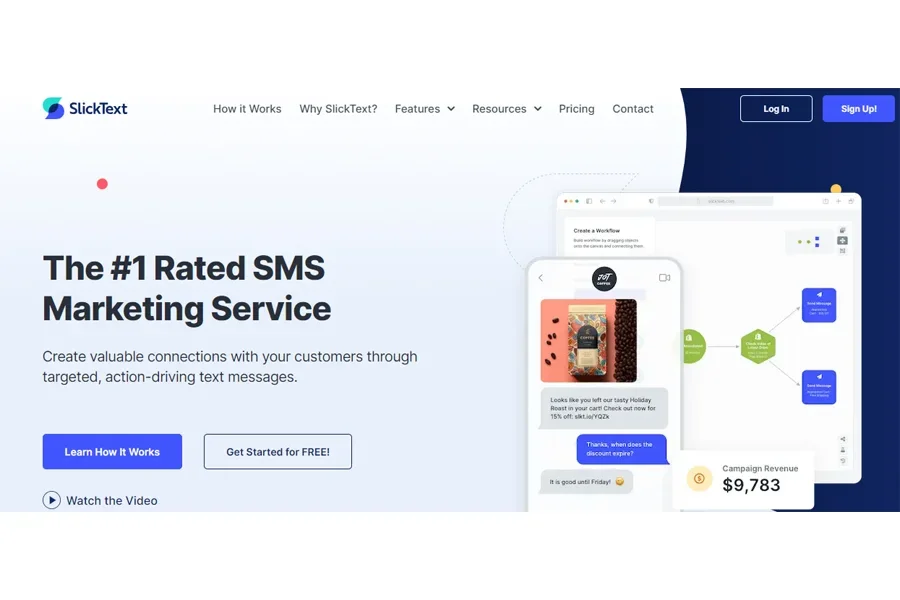Every retailer has something in common: they all have mobile phones, just like their potential and existing customers. The world has more than 6.71 billion mobile phone users, meaning they are an excellent way to promote any business. That’s where SMS marketing comes in.
SMS marketing is one of the most influential and enduring ways businesses can connect with customers. Despite some negativity surrounding sending unauthorized texts, retailers can make it work with some key insights and boost their digital marketing strategies. This article explores everything about SMS marketing, covering its advantages, best practices, and examples to help retailers stay ahead of the competition.
Table of Contents
The basics of SMS marketing
6 SMS marketing strategies businesses can use for their customers
SMS marketing best practices: 7 tips retailers must follow before using these strategies
4 SMS marketing software worth trying in 2024
Final words
The basics of SMS marketing

SMS (short message service) marketing, also known as text marketing, allows businesses to send text messages to customers and potential clients. It offers significant advantages over other strategies (like email marketing), mainly when brands use them to deliver shipping notifications, promotional offers, appointment reminders, and discounts. One key benefit is the high open rate for SMS (98% on average)—five times better than email’s 20% open rate.
This stat means customers are likelier to see a text message than an email. Additionally, SMS marketing has an impressive click-through rate (9.18%), much higher than email’s 2.5%. The statistics prove that SMS marketing is effective for brands to reach their target audience with clear, concise messages. Here are other noteworthy benefits:
1. Reach customers quickly
SMS is an excellent option for sharing urgent information since 95% of texts are opened within three minutes. Businesses can use SMS to notify customers about limited-time offers or new sales.
2. Boost response rates
If retailers want direct customer communication, SMS marketing is the way to go. Customers are 134% more likely to answer text messages over email—and this higher response rate keeps customers engaged and leaves the door open for further offers.
3. Enhance different marketing channels
Although SMS marketing works well, retailers can use them to complement other channels. For instance, SMS is a great way to promote social media contests, increase email newsletter subscribers, or remind customers about upcoming events or webinars.
4. Retain more loyal customers
Do businesses want to build customer loyalty? They can send personalized messages and offers through SMS. Personalized texts make customers feel more special and increase the chances of repeat purchases.
5. Grow revenue
SMS marketing can drive massive traffic to stores or websites, boosting revenue by large margins. By using text messages to promote special sales and events or remind customers to complete their purchases, retailers can enjoy SMS marketing’s convenience. Plus, it also integrates smoothly with any overall marketing strategy.
6 SMS marketing strategies businesses can use for their customers
With everything SMS marketing offers, it’s a no-brainer for businesses hoping to enhance their offers. But before they dive into this marketing technique, here are six strategies to help them be at the top of their SMS game.
1. Use welcome messages for new subscribers
Customers can’t receive texts from businesses if they don’t subscribe. So, when they do, retailers must send them welcome messages to engage them immediately while acknowledging their subscription. Even better, welcome messages are perfect for setting the stage for future interactions.
However, there’s no need to do too much for welcome messages. They could be simple and short, like “Thank you for subscribing!” Businesses can make things more interesting by adding coupon codes or special offers.
2. Send out new product releases
Who said new product release announcements only make sense in emails and social media? Businesses can also share this news through SMS, which is very effective. SMS marketing can help share exciting news with subscribers and engage customers who haven’t made recent purchases.
Check out this example: “Explore our new arrivals!” It’s a great (and short way) to encourage people to visit the site and explore the latest products—don’t forget to add a direct link.
3. Follow up on abandoned carts
Abandoned carts are a common and annoying issue for many retailers. Most businesses see a 70.19% cart abandonment rate, meaning they often lose significant revenue. However, businesses can stop some of the losses with SMS marketing. How? Target customers with items hanging in their online carts with well-crafted messages—just to serve as a little reminder.
4. Let customers know about re-stocked products
Nothing is more frustrating for consumers than searching for an out-of-stock item. But businesses don’t have to miss out, either! They can use SMS marketing to let customers know when what they are looking for is restocked. Retailers may also use this channel to show them similar products on sale.
5. Gather customer feedback

Businesses that don’t listen to or gather customer feedback often fail. Thankfully, retailers can use SMS surveys to obtain this necessary feedback quickly, and creating them is easy, too.
Businesses can create surveys using SurveyMonkey and Google Forms and send the links via SMS. Alternatively, retailers can ask subscribers to rate them from five to one. Then, they can target those who respond with low ratings to help improve their experience.
6. Promote in-person and online events
Are retailers planning exciting events? SMS marketing can be their perfect hype man. Businesses can promote any special event, even through text messages, making it a great way to keep customers engaged while creating excitement. Here’s what these event reminders should have:
- The event’s date, location, and time.
- A call-to-action encouraging ticket purchases or sign-ups.
- A website or event page link (if any).
- Give attendees more details about what to expect.
- The hashtags customers can use to promote the event on social media.
- Strategically use emojis. They are a great way to boost engagement.
Note: If the event has limited spots, ensure texts have links to help customers secure their participation.
SMS marketing best practices: 7 tips retailers must follow before using these strategies
1. Don’t send texts without permission

Never text customers who don’t sign up—it’s a privacy invasion. Instead, retailers must only send SMS to those on their subscriber list. One perfect way to gain subscribers is through opt-in forms on websites and other online channels. But it doesn’t end there. Even with an opt-in, businesses must still send a welcome text to thank new subscribers and ask them to confirm their choices with a “Y” or “N: response.
2. Don’t make opting out difficult
SMS marketing needs trust to be successful. If businesses use this strategy in a scummy way, they will only push potential customers away. Thankfully, it’s easy to build this trust in customers, especially when retailers make opting in and out straightforward.
Don’t worry about easy-to-unsubscribe options reducing the number of subscribers. It’s not worth the negative attention if they can’t opt out. Instead, look forward to the remaining recipients—those potential customers with enough interest to make a purchase. Usually, the results are better conversion and engagement rates.
3. Always start with a brand introduction

Don’t waste time before introducing a brand. Consumers will not have the businesses’ numbers, so retailers risk losing their attention if they introduce their brand immediately. Doing this helps subscribers recognize who sent the text and respond appropriately. Remember, businesses must always start with the brand name and follow up with their offers.
4. Use SMS to inform more than promote
Since opting out of SMS messages is easy, brands should respect buyers’ patience. Most messages must have value—they could have information on order updates, events, dates, and other essential things. Cut down promotional messages and send them only once a week—it’s the best way to avoid looking salesy.
5. Don’t tell a story
Never go beyond the limit in SMS marketing. Retailers must ensure whatever they want to convey fits within the 160-character limit. They shouldn’t add unnecessary content to boost open rates and clicks. Here’s an example of an excellent SMS campaign framework:
- Company name
- Customer name
- Enticing offers or promotions
- Conditions for opting-in
- Strong call-to-action
- Opt-out option
Including an opt-out option makes consumers feel more comfortable since it’s presented as a choice. If needed, use a shortened link for more information.
6. Avoid sending random messages without context
Don’t send random messages—it hurts the brand more than many think. When crafting texts, businesses must ensure they have enough context. Such messages have a higher chance of generating clicks without losing subscribers’ goodwill. If businesses send random messages, most consumers will flag them as spam.
7. Personalize your SMS marketing strategy
SMS marketing can also use customer data to segment SMS lists and make messages much more personal. Some tools can do this based on browsing behavior, shopping time, past purchases, and location. Personalized messages have higher chances of generating better conversion and engagement rates.
For example, if a clothing store knows some repeat customers who shopped for summer dresses, it can text them to alert them about new arrivals. Or, if some buyers prefer shopping at night, retailers can set text messages with promo codes to reach these customers when they are active.
4 SMS marketing software worth trying in 2024
1. Attentive

Attentive is one of the top SMS marketing software due to its user-friendly interface. Integrating with any brand’s email subscriber lists is simple, and users can easily create targeted messages for different customer groups.
2. SlickText

SlickText offers seamless integration of any software through a global API platform. For this reason, the tool provides an impressive SMS marketing service. SlickText also comes packed with text message scheduling, user engagement analytics, and two-way messaging—all for a great user experience.
3. Klaviyo

Klaviyo deserves a spot on this list because of its omnichannel nature. The platform has advanced automation and segmentation features, making it incredibly unique. More importantly, Klaviyo allows retailers to target customers based on behavior and preferences. This feature often leads to increased conversion, mainly when retailers use it with other marketing channels.
4. Birdeye
Birdeye is easy to use, even for those without technical skills. However, its simple integrations with social platforms (including X and Instagram) make it stand out. Hence, retailers can add visuals to their SMS marketing campaigns and expand their reach to other platforms instead of just one or two.
Final words
SMS marketing is one of the most effective ways brands can reach their target audience and boost engagement. It takes a brand’s marketing efforts straight to where customers are the most active, increasing their chances of capturing (and retaining) attention.
That’s why experts encourage businesses to try different SMS strategies when they start—it helps get a feel of what resonates with their customers. Then, they can pinpoint what works and add it to their overall marketing to boost results exponentially.



